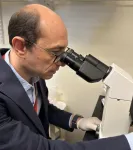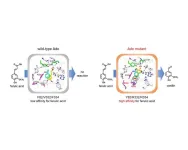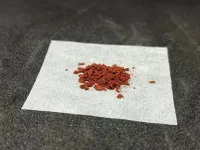(Press-News.org) If you tend to do other things or get distracted while eating dinner, you may be running the risk of over-consuming everyday pleasures later, possibly because the distraction caused you to enjoy yourself less, according to research published by the American Psychological Association.
The study looked at how distraction affects “hedonic consumption,” or buying and using products and experiences because they make us feel good and not necessarily because we need them.
“On any given day, a person may take great pleasure from one or more of these activities, yet people often consume more hedonic goods than they want or than is good for them,” said lead author Stephen Lee Murphy, PhD, of Ghent University.
One reason for this overconsumption may be distraction, according to Murphy. When people are distracted while engaged in a hedonic activity, research suggests they are likely to experience less enjoyment from it than if they were fully focused. That may lead to feelings of dissatisfaction and drive more consumption to compensate for that shortfall.
The research was published in the Journal of Personality and Social Psychology.
To better understand the role of distraction in overconsumption, the researchers first conducted an experiment involving 122 participants (mostly female and mostly between the ages of 18 and 24) who reported on how much they expected to enjoy their lunch before eating it. They were then asked to eat their lunch under one of three conditions: no distraction, moderate distraction (watching a video), and high distraction (playing Tetris). After lunch, participants reported on their actual enjoyment, satisfaction, desire for further gratification and amount consumed. They also reported on their snacking later in the day.
Participants who ate while distracted reported lower enjoyment and satisfaction, which was associated with increased snacking afterward and a more general desire for further gratification.
The researchers believe that this proposed effect, which they called “hedonic compensation,” likely applies to other activities beyond eating. For example, people who are distracted while watching a movie or playing a game may be more likely to engage in additional consumption (e.g., checking social media) to compensate for a diminished enjoyment of the original activity.
The researchers also followed 220 participants aged 18 to 71 (again mostly female) for a week to investigate this broader effect, beyond food. Participants filled out seven brief surveys per day via their smartphones regarding their hedonic consumption, distraction and satisfaction. As with the food-based experiment, researchers found that when people were distracted during consumption, they were likely to enjoy a product less than they hoped, felt less satisfied, and experienced an elevated need for further gratification.
"Overconsumption often results due to a lack of self-control," said Murphy. "However, our findings suggest overconsumption may also often be driven by the simple human desire to reach a certain level of enjoyment from an activity. When distraction gets in the way, it’s likely we may try to compensate by consuming more."
Murphy and his colleagues plan to conduct further research to replicate and confirm the existence of a hedonic compensation effect. If additional research confirms the effect, they have plans to apply interventions that could help people pay more attention to their consumption experiences in an effort to lower the likelihood of overconsumption.
"By understanding the key drivers of hedonic overconsumption, we can develop strategies to help prevent its occurrence," said Murphy.
ARTICLE: “Underwhelming Pleasures: Towards a Self-Regulatory Account of Hedonic Compensation and Overconsumption,” by Stephen Lee Murphy, PhD, Ghent University; Floor van Meer, PhD, Lotte van Dillen, PhD, and Henk van Steenbergen, PhD, Leiden University; and Wilhelm Hofmann, PhD, Ruhr University Bochum. Journal of Personality and Social Psychology, published online May 16, 2024.
CONTACT: Dr. Stephen Murphy can be reached at stephen.murphy@ugent.be.
The American Psychological Association, in Washington, D.C., is the largest scientific and professional organization representing psychology in the United States. APA’s membership includes over 157,000 researchers, educators, clinicians, consultants and students. Through its divisions in 54 subfields of psychology and affiliations with 60 state, territorial and Canadian provincial associations, APA works to advance the creation, communication and application of psychological knowledge to benefit society and improve people’s lives.
END
Why do we overindulge?
Being distracted while engaging in enjoyable activities can reduce satisfaction, lead to overcompensation, study says
2024-05-16
ELSE PRESS RELEASES FROM THIS DATE:
Lily Ng and Douglas Forrest of NIDDK win Endocrine Society’s 2024 Endocrine Images Art Competition
2024-05-16
WASHINGTON—The Endocrine Society is delighted to announce that Lily Ng, PhD, and Douglas Forrest, Ph.D., have won the Society's 2024 Endocrine Images Art Competition for their image of the astrocyte cell that expresses type 2 deiodinase.
Now in its third year, the Art Competition celebrates the beauty of endocrine science as seen through the lens of a microscope. This year’s 19 entries were judged by a panel of Society members who based their assessments on aesthetic value of the images and their significance ...
New postpartum care recommendations target CVD risk
2024-05-16
DALLAS, May 16, 2024 — Pregnancy-related deaths in the U.S. have risen 140% over the past three decades and cardiovascular disease is the leading cause.[1] Despite existing medical guidance on pregnancy and cardiovascular health, current trends in health outcomes suggest a significant opportunity for an improved system of care, particularly in the postpartum period.
The American Heart Association, the world’s leading voluntary organization focused on heart and brain health and this year ...
TTUHSC’s Ahmed investigating cardiac cell regeneration
2024-05-16
When a patient is experiencing heart failure, a leading cause of death worldwide, they begin to lose healthy and functioning cardiac cells. Heart failure causes these once-flexible cells to develop into fibrotic cells that are no longer able to contract and relax. This stiffening of the cardiac cells compromises their ability to carry blood efficiently to the rest of the organs in the human system. Because humans cannot regenerate these cardiac cells, the patient faces a long road to recovery marked by preventative or symptomatic treatments.
However, some ...
Bioengineered enzyme creates natural vanillin from plants in one step
2024-05-16
Vanilla extract is one of the most widely used flavoring compounds in food products and cosmetics. The pleasant and sweet smell of this classic flavor is imparted by the chemical compound ‘vanillin’ found in the seed pods of vanilla plants belonging to the orchid family. In plants, vanillin is synthesized by the conversion of ferulic acid by the enzyme - VpVAN. However, laboratory biosynthesis of vanillin from plant-derived VpVAN yields only very small quantities of vanillin, and is, therefore, commercially impractical. Further, although chemically derived ...
How does the brain turn waves of light into experiences of color?
2024-05-16
NEW YORK, NY — Perceiving something – anything – in your surroundings is to become aware of what your senses are detecting. Today, Columbia University neuroscientists identify, for the first time, brain-cell circuitry in fruit flies that converts raw sensory signals into color perceptions that can guide behavior.
Their findings were pulbished in the journal Nature Neuroscience.
“Many of us take for granted the rich colors we see every day – the red of a ripe strawberry ...
Wind farms can offset their emissions within two years, new study shows
2024-05-16
After spinning for under two years, a wind farm can offset the carbon emissions generated across its entire 30-year lifespan, when compared to thermal power plants.
That’s according to a new peer-reviewed study published in the Journal of the Royal Society of New Zealand – which also shows within six months a turbine can generate all the energy consumed across its life-cycle.
The research uses data from the Harapaki onshore wind farm in Hawke’s Bay, New Zealand – however the authors of the paper explain that their findings would be replicated across most, if not all, wind farms internationally.
“The wind turbine technology employed in New Zealand ...
One in three people die due to atherosclerosis: A new initiative aims to find new ways to prevent it
2024-05-16
One in three people around the world die from cardiovascular disease, which is mainly caused by atherosclerosis. This makes atherosclerosis the leading cause of death globally. Additionally, many people live with serious manifestations of atherosclerosis, for example, following a heart attack or a stroke.
Atherosclerosis not only represents a significant burden for these individuals, but also a heavy burden on healthcare systems and societies in all parts of the world.
“Atherosclerosis may develop from an early age and often remains 'silent’, that is, without symptoms, ...
More efficient bioethanol production might be possible using persimmon tannin to help yeast thrive
2024-05-16
While ethanol in alcoholic beverages impairs drinkers’ motor functions, it is that same substance that can power motor vehicles in a cleaner, more sustainable manner. What is necessary for the production of ethanol is yeast, but ethanol is among the environmental factors that add stress to yeasts, hindering their growth. To promote efficient bioethanol production, scientists have been searching for substances that can help yeasts better withstand ethanol, but few effective ones have been found.
An Osaka Metropolitan ...
What is the carbon footprint of a house in Japan?
2024-05-16
Fukuoka, Japan—Researchers at Kyushu University have published a comprehensive analysis on the carbon footprint of constructing a wooden house in Japan. The study covered the total amount of emissions produced, taking into consideration the entire supply chain including the processing and transport of the raw materials that go into building a house.
The team hopes that by identifying emission hot spots in the supply chain that go into building a house, policy makers can implement strategies to reduce its climate impact. Their analysis was published in the Journal of Environmental ...
University of Oregon researchers uncover how jelly sea creatures might shape modern robotics
2024-05-16
Scientists at the University of Oregon have discovered that colonies of gelatinous sea animals swim through the ocean in giant corkscrew shapes using coordinated jet propulsion, an unusual kind of locomotion that could inspire new designs for efficient underwater vehicles.
The research involves salps, small creatures that look similar to jellyfish that take a nightly journey from the depths of the ocean to the surface. Observing that migration with special cameras helped UO researchers and their colleagues capture the macroplankton’s graceful, coordinated swimming behavior.
“The largest migration on the planet ...
LAST 30 PRESS RELEASES:
Post-stroke injection protects the brain in preclinical study
Cardiovascular risk score predicts multiple eye diseases
Health: estimated one in ten British adults used or interested in GLP-1 medications for weight loss
Exercise to treat depression yields similar results to therapy
Whooping cough vaccination for pregnant women strengthens babies’ immune system
Dramatic decline in new cases of orphanhood in Uganda driven by HIV treatment and prevention programs
Stopping weight loss drugs linked to weight regain and reversal of heart health markers
Higher intake of food preservatives linked to increased cancer risk
Mass General Brigham–developed cholera vaccine completes phase 1 trial
First experimental validation of a “150-year-old chemical common sense” direct visualization of the molecular structural changes in the ultrafast anthracene [4+4] photocycloaddition reaction
Lack of support for people on weight loss drugs leaves them vulnerable to nutritional deficiencies, say experts
Dogs’ dinners can have greater climate impact than owners’
Are you ready to swap salmon for sprats and sardines?
1.6 million UK adults used weight loss drugs in past year
American College of Cardiology comments on new dietary guidelines for Americans
American Society of Gene & Cell Therapy and Orphan Therapeutics Accelerator partner to advance and commercialize promising rare disease treatments
One in 14 patients having day case surgery have new or worse chronic pain 3 months after their operation
New study highlights link between eviction rates and gun violence
Heatwaves heat up soil but not toxin levels in rice, study finds
Digital modeling reveals where construction carbon emissions really come from
Turning farm waste into water filters
New study shows how the spleen helps the immune system accept a transplant
New Mayo Clinic study advances personalized prostate cancer education with an EHR-integrated AI agent
Researchers identify novel therapeutic target to improve recovery after nerve injury
Microbes in breast milk help populate infant gut microbiomes
Reprogramming immunity to rewrite the story of Type 1 diabetes
New tool narrows the search for ideal material structures
Artificial saliva containing sugarcane protein helps protect the teeth of patients with head and neck cancer
Understanding the role of linear ubiquitination in T-tubule biogenesis
Researchers identify urban atmosphere as primary reservoir of microplastics
[Press-News.org] Why do we overindulge?Being distracted while engaging in enjoyable activities can reduce satisfaction, lead to overcompensation, study says




